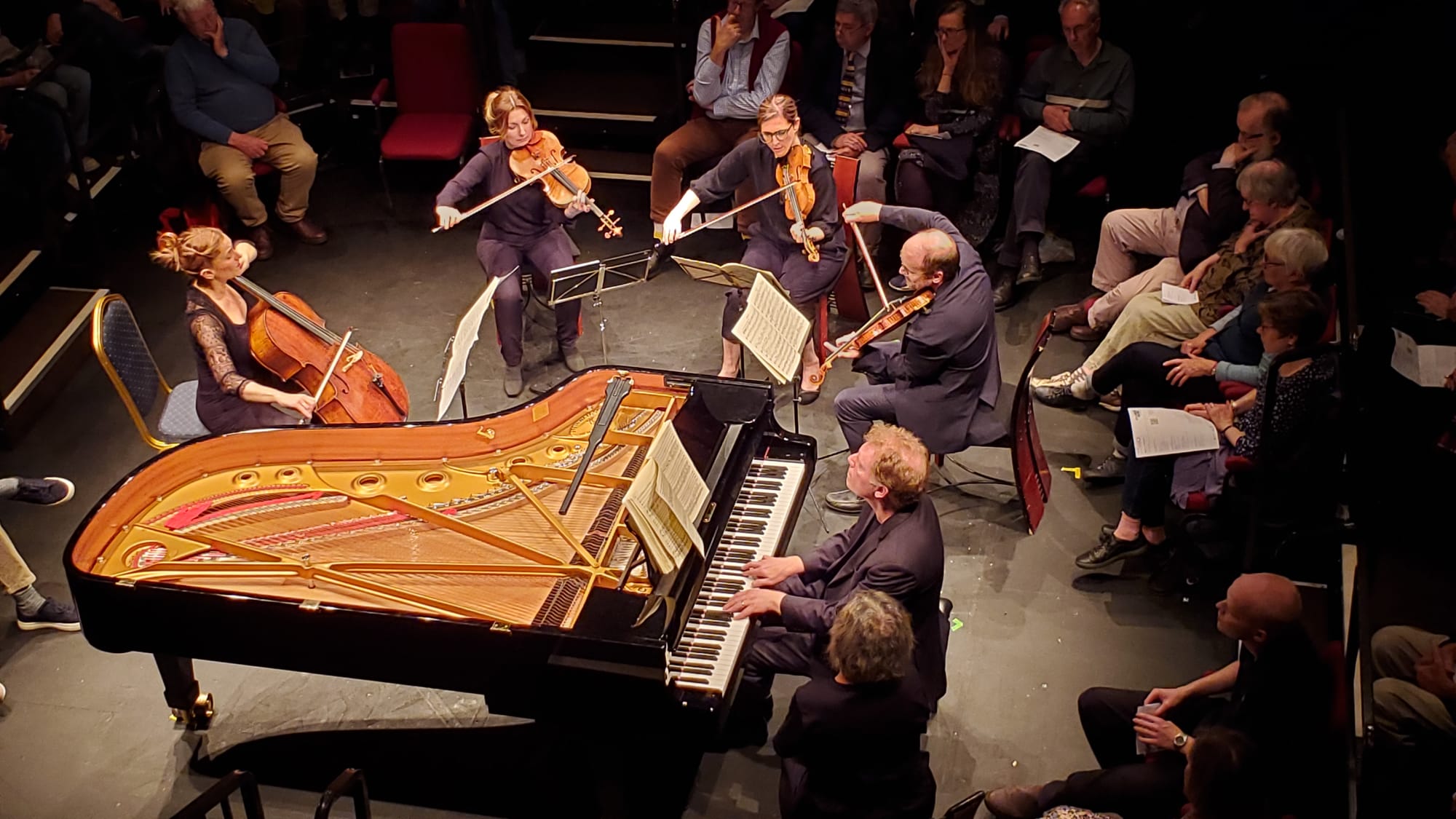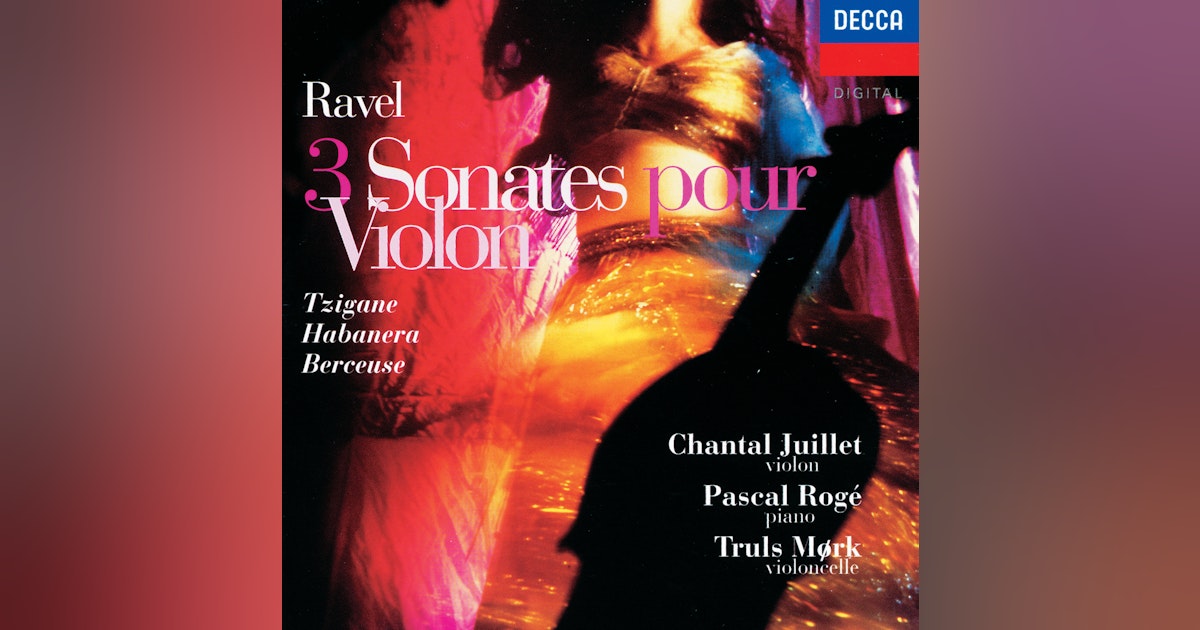
Ensemble 360. Crucible Playhouse, 22.05.2024
Ravel Berceuse sur le nom de Gabriel Fauré, MA 74 (1972)
Saint-Saëns Oboe Sonata in D major, Op. 166 (1921)
Adès Alchymia (2021)
Messager Solo de Concours (1899)
Franck Piano Quintet in F minor, FWV 7 (1879)
The Sheffield Chamber Music Festival continued with this superbly and intelligently programmed evening of ‘French Gems’. Gems they all were, although perhaps not all are so well-known. For me, it was César Franck’s Piano Quintet that was the draw (as pianist Tim Horton pointed out in his spoken introduction, Franck was of course Belgian).
To begin, Benjamin Nabarro and Tim Horton delivered a restrained performance of Ravel’s short Berceuse in tribute to his teacher, Gabriel Fauré, Nabarro’s violin deliciously sweet-toned. It was the perfect way to draw the listener into the beauty of the evening. There are quite a few available performances of this piece, here’s a particularly lovely one, Chantal Juillet and Pascal Rogé on Decca:
After the previous night’s Saint-Saëns extravaganza, and the resultant stirred enthusiasm, it was good to see hat composer’s late Oboe Sonata, a piece only around 12 minutes long, but beautifully concentrated as well as being, simply, beautiful, This was the first of the late sonatas Saint-Saëns wrote, and it breathes serenity. Adrian Wilson was the superb oboist, completely in control (the opening theme changes registers quite rapidly, including down into the instrument’s notorious lower end). Wilson was joined by the ever-sensitive Tim Horton (who seemed o particularly revel in Saint-Saëns’ sophisticated harmonic twists in this piece). The pace of that opening movement is Andantino, fast enough to flow and slow enough for all details to register, and Wilson and Horton allowed the music the perfect space to breathe.
To hear the movement, here’s the wonderful Heinz Holliger with Andrej Kernjak:
The central “Ad libitum” is a cross between pure French Impressionist Pastoralism and the pipings of the third act of Tristan. A heady mix, one might think, and it is indeed so; the central Andanino is light as a soufflé, the gentle dotted rhythms here perfectly placed by Wilson. Finally, a Molto allegro, charming in its pecking staccatos with just the right amount of gentle excitement. A fabulous performance of a fabulous piece.
For a performance of the entire piece with score animation, here’s Albrecht Meyer and Karina Wisniewska:
Thomas Adès has a love of both Fauré and Couperin; his basset clarinet quintet Alchymia (2021) was written exactly 100 years after Saint-Saëns’ Oboe Sonata.. The title is Latin for alchemy (the Arabic root is kīmiyā). Alchemy is a process of transformation, and in his work, Adès plays with two modes of expression: ruminative spaces are pitted against territories demanding real precision. Presumably the base metals are the four movements here: the slowly carved descents of “A Sea-Change ( … those are pearls)” reveal a veiled world replete with mystery, the control of Robert Plane equal to that of his string counterparts (Benjamin Nabarro and Claudia Ajmone-Marsan, violins; Rachel Roberts, viola; Gemma Rosefield, cello). ‘The Woods So Wild’ is elusive, but rapid. It is based on a popular street song that William Byrd had himself written variations on, the movement’s final arrival point like a ray of sunshine through a forest. The performance was note perfect, but this was more than virtuosity; it was intimate chamber music of the highest rank, a true evocation of the ineffable.
If Byrd informed ‘The Woods So Wild,’ it is inevitable that a movement entitled ‘Lachrymae’ more than nods to John Dowland. The movement returns to the slow-moving, but here the pace is glacial, the harmonies often aglow. This music demands just as much as the overt virtuosity of the piece’s second movement scherzo, and the result was indeed transfixing. Finally, a set of ‘divisions’ (nodding again to Byrd, his early keyboard music) on a theme from Berg’s Lulu. The theme itself was by Wedekind, a song in which a sex-worker sings of her life, and which Berg incorporated into an orchestral interlude in his opera. In the Berg, the song appears almost like a barrel organ, and Adès takes his and presents it through a sonic fairground mirror. The procedure is fascinating, and the resultant music like no other. A special note, perhaps for violist Rachel Roberts’ lyrical playing in this movement.
Adès’ piece also self-references his opera The Tempest (based on Shakespeare’s own evocation of magic – and alchemy is, after all, a magickal process). It is a masterly. piece, and it was hard to imagine a more masterful performance.
We met Robert Plne previously via his Champs Hill disc, Reawakened. Here, though, is another fine account, Mark Simpson with Quatuor Diotima:
It is difficult to imagine a more different piece than that which launched the second half, André Messager’s Solo de Cnncours for clarinet and piano. It is lovely, fragranced, easy-going (and at one point, rather bizarrely seems to want to morph into the Khachaturian of The Onedin Line!). There is the most beautiful cadence in the approach to the cadenza – both beautifully rendered here, with Robert Plane relishing the release from the leash in the cadenza itself.
Here’s a performance with the equally wonderful Martin Fröst and Roland Pöntinen (with score):
Finally, Franck’s impassioned Piano Quintet, a big-boned, 35-minute piece asking for maximal virtuosity from all. Horton was in complete command (Frank’s demands are positively monumental): the quartet of strings (Nabarro, Ajmone Marsan, Roberts Rosefield) was in perfect accord both within itself and with piano. Dialogues between piano and strings brought the piece into the realm of the heroic in the first movement, while the central Lento con molto sentimento was awash with lyricism, often of the glowing variety. This was expressive but not sentimental in the negative sense, the perfect contrast to the buzzing opening to the finale. The sense of a vast structure was present throughout; a structure that included not only incendary passages, but also moments of high beauty. The performance was a reminder of the stature of his work as masterpiece. Superb.
Another performance of note, to supplement those available commercially, is this one by Sviatoslav Richter and the Borodin Quartet from 1986:
.. but for a collection, the Verbier Festival performance issue by DG with Marc-André Hamelin, Joshua Bell, Pamela Frank, Nobuko Imai, and the cellist who is also the curator of this year’s Music in the Round, takes some beaing (links below).
Currently, the Ravel Sonatas disc quoted above is going for the silly price of £4.17 on Amazon here.










